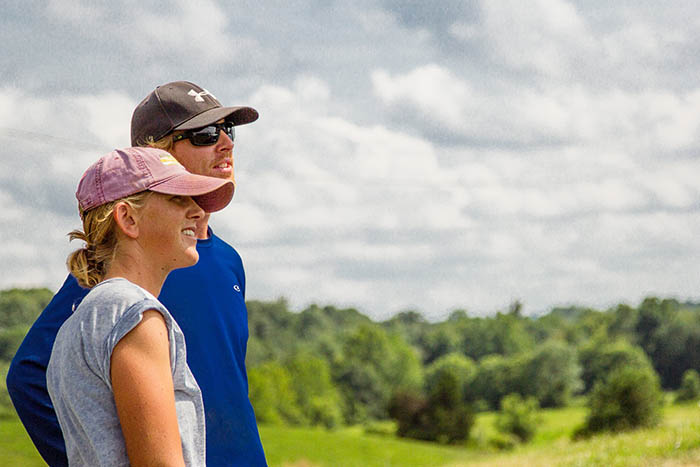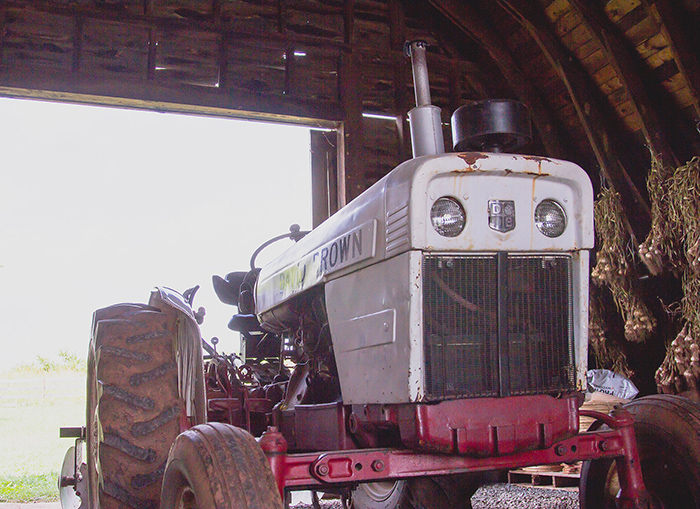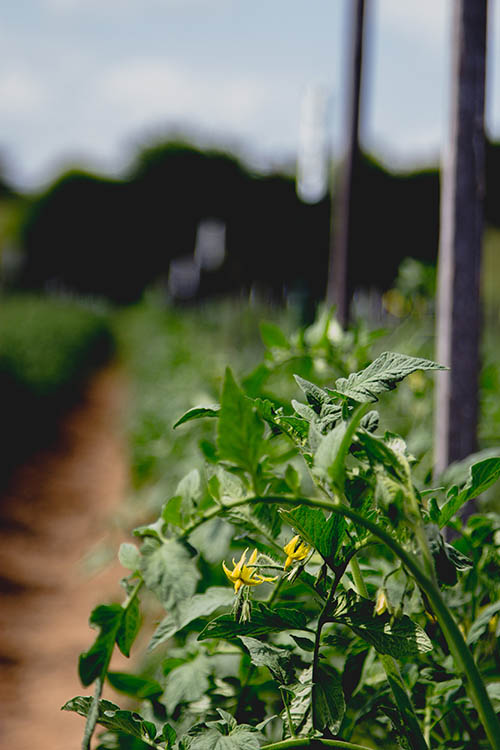What happens next door matters
Holly Hammond grew up on a you-pick vegetable farm in Arizona that her parents ran. She had no intention of following in their footsteps as farmers, hobby or otherwise, and neither did her husband, James Hammond, when they married in 2002.

At least, not in Arizona. “It just didn’t make sense to try to grow food there,” said Holly, 32. The Hammonds came to Virginia in 2007, but it would take two years — and a little hiking — before they’d find “the farm.”
“We had actually no idea what it took to start a farm. We didn’t know about interning; we didn’t know about any of that stuff,” Holly said last summer from the kitchen of their 1930s farmhouse in Rapidan. A pair of seasonal interns weeded vegetable beds beyond the window as she plopped a jar of her pickled cucumbers on the table.
“People are always like, ‘Oh, you found the farm!’” said James, 37, but “it was a long way around.”
Holly and James began to seriously consider growing food for a living after starting a community garden in their Phoenix neighborhood and reading books by Wendell Berry about what was wrong with modern agriculture. James had grown up in Greensboro, NC, with fervent gardeners as parents and a father who’d been raised on a tobacco farm. But he chose a career in professional baseball, which eventually brought him to Arizona for training. After meeting and marrying Holly, he stayed there for several years.

Holly’s parents had since divorced and sold the farm in Arizona. Her dad now had some land in Virginia, a state that, at the very least, promised more hospitable growing conditions for a fledgling farm. But James and Holly never ended up farming the land owned by her dad.
Instead, they hiked the Appalachian Trail, moved back to Arizona and then back to Virginia before stumbling upon Waterpenny Farm online. The small, organic operation in Rappahannock County was looking for interns, and the Hammonds were looking to learn the trade. The couple also signed up for a program offered by The Piedmont Environmental Council on “Exploring the Small Farm Dream.”
Finding the farm
After interning at Waterpenny for a year — “the best experience we could have hoped for” — their plans to stay on for another year were interrupted when they found some farmland of their own to lease.
Leasing 10 acres with a house for $800 a month met their criteria, and “we were so eager to start farming.” The property in Culpeper County included an old barn and several storage sheds. Rolling hills gave way to some flatter portions of river bottom-like land that would be ideal for growing produce, and a creek could provide irrigation.
“Lots of people have land, but it doesn’t have the infrastructure in place that would make something like this feasible,” said James, who had looked at a handful of other properties by the time this opportunity arose. The parcel represented a small fraction of the total farmland the family owned in the area, and the Hammonds liked the autonomy that came with landowners living off-site. The house and outbuildings were “a little rundown,” but the Hammonds, who wanted to farm organically, liked that the ground hadn’t been intensively farmed for several years.
“Lots of people have land, but it doesn’t have the infrastructure in place that would make something like this feasible.”
In January 2010, they moved in.
Over the past five years, the couple has used this land to build a greenhouse, cold storage, an irrigation system — and a sturdy farm business raising four acres of vegetables, herbs and cut flowers without the use of synthetic chemicals. They sell the produce at two farmers markets and through a community supported agriculture (CSA) program, making more money each year.
Holly said leasing land allowed them to get to know the landscape and establish a business without having to take on a mortgage right away.
“We spent like $40,000 before we’d even been to our first farmers market. So if we had bought a property that we weren’t sure about, too, that would have been really stressful,” she said.
Last summer, the Hammonds were so pleased with the arrangement that they’d begun to consider drafting a long-term lease.

Lessons learned
And then the unexpected happened.
The Hammonds knew that the land surrounding their farm, owned by the same family, was used to graze cattle and grow hay. They knew that the chemical fertilizers that are heavily used in the agricultural county might be used nearby (and that tests of their drinking water had recently revealed it was high in nitrates).
Then, last summer, the farmer working the land uphill from their own — 400 feet from their home and the well that waters it — applied biosolids as fertilizer.
Biosolids are sewage sludge, including human waste, that’s been treated to remove pathogens and reduce the presence of heavy metals. The state considers the processed sewage safe for application on land and regulates its use as a fertilizer.

But that doesn’t make it “organic” — far from it — and the Hammonds considered the new addition problematic enough that they were looking for a new place to farm after the season was over.
“I didn’t quite understand how much someone up above you or a river below you could impact you. We didn’t have enough experience farming to see it all,” James said.
Now, “when it rains really hard, we see streams of water coming down from there,” he said, pointing to the hill just beyond their barn where biosolids were spread. “That hasn’t happened since (it was spread), but it’s inevitably going to contaminate our operation.”
The Hammonds hadn’t thought much about biosolids until they discovered — and smelled — them being applied on the nearby field. James said they’ve come to realize that what happens around them impacts everything from their drinking water to their own business’ integrity.
The Hammonds were interested in including a land-use agreement in a long-term lease, one that would stipulate what can be applied on the fields surrounding them even if they’re not leasing them. But, based on recent conversations with their landowners, who had been receptive to the idea of a long-term lease, the Hammonds realized they might not agree to limitations on the land.
“I think a main lesson is we have to work with people that really get it, really value the same things, because farming is just way too hard to be up against people who… I’m sure they think we’re crazy,” Holly said. James added that they don’t blame the landowners for using an additive that the state still considers fairly harmless, though regulations are evolving. But, for them, “it’s just as far from the other end of the spectrum of organic farming as there is.”
“I didn’t quite understand how much someone up above you or a river below you could impact you. We didn’t have enough experience farming to see it all.”
The Hammonds said they’ve learned a lot from their first five years of renting farmland, and that this recent incident has taught them how important it is to work with likeminded landowners. They’d even consider buying a piece of property now that they’ve saved enough money over their first five years.
“I would rather never farm again than be subjected to stuff that’s against all the reasons why we got into organic farming,” James said. “There are plenty of people out there who value what we’re doing, who would be proud of it.”
In the fall of 2014, Whisper Hill Farm relocated to Scottsville, Virginia. They are excited to be leasing from landowners who value organic production. Whisper Hill will be certified organic for the 2015 growing season.
This story is part of “Finding a Place to Grow“, a publication produced by The Piedmont Environmental Council. The stories were written by Whitney Pipkin, a freelance journalist from Alexandria, VA who covers food, farms, and the environment. Her work appears in the Washington Post, Virginia Living and the Chesapeake Bay Journal, among others, and she writes at thinkabouteat.com. Photos were taken by Jami McDowell.
The publication was made possible by a grant from The Beirne Carter Foundation.
